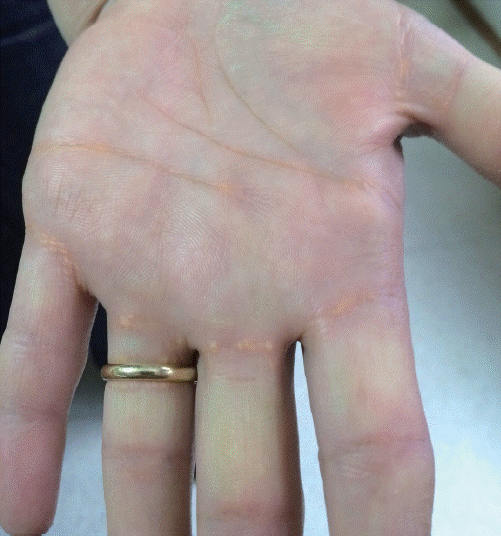Fifty-year-old female without a known disease was admitted with weakness and fatigue. In family history, her sister had a myocardial infarction when she was 55 years old and hypertriglyceridemia, her father and mother have hypertension but donŌĆÖt have dyslipidemia. On physical examination body weight 76 kg, height 165 cm, body mass index 27.9 kg/m2, abdominal circumference 92 cm, xanthomas were found in her the palms (Fig. 1). Laboratory tests were as follows: serum cholesterol 480 mg/dL (normal range, 0 to 150), triglycerides 627 mg/dL (normal range, 0 to 150), high density lipoprotein 44 mg/dL (normal range, 35 to 65), low density lipoprotein 102 (normal range, < 130), fasting glucose 95 mg/dL (normal range, 82 to 115), hemoglobin A1c 6%, hemoglobin 10 g/dL (normal range, 13 to 18), mean corpuscular volume 102 fL (normal range, 80 to 97), leukocyte 10,000/mm3 (normal range, 4 to 10,000), platelet 102,000/mm3 (normal range, 142 to 424,000), vitamin B12 46 pg/mL (normal range, 187 to 880), and folate 8.1 ng/mL (normal range, 3 to 20). But due to technical insufficiencies of our hospitalŌĆÖs biochemical laboratory; lipoprotein electrophoresis, apolipoprotein E typing, phospholipid testings could not be revealed. Peripheral blood smear confirmed megaloblastic anemia. We thought it could possibly familial type III hyperlipoproteinemia (T3HL) and megaloblastic anemia. She was started on fibrate and cobalamin treatments. After 3 months of follow-up triglycerides and total cholesterol was back to normal. The presence of xanthomas continued.
T3HL, which is characterized by the accumulation of ╬▓ very low density lipoprotein, may be considered as an early atherosclerosis indicator. Palmar xanthoma (palmar xanthoma striatum) is a rare but is an early and specific marker of T3HL.




 PDF Links
PDF Links PubReader
PubReader ePub Link
ePub Link Full text via DOI
Full text via DOI Download Citation
Download Citation Print
Print





